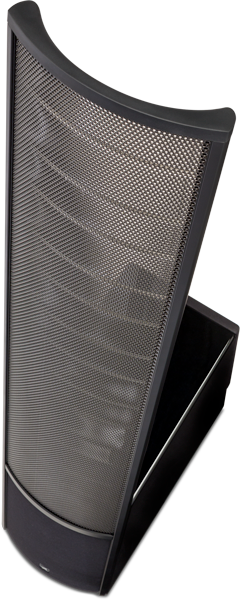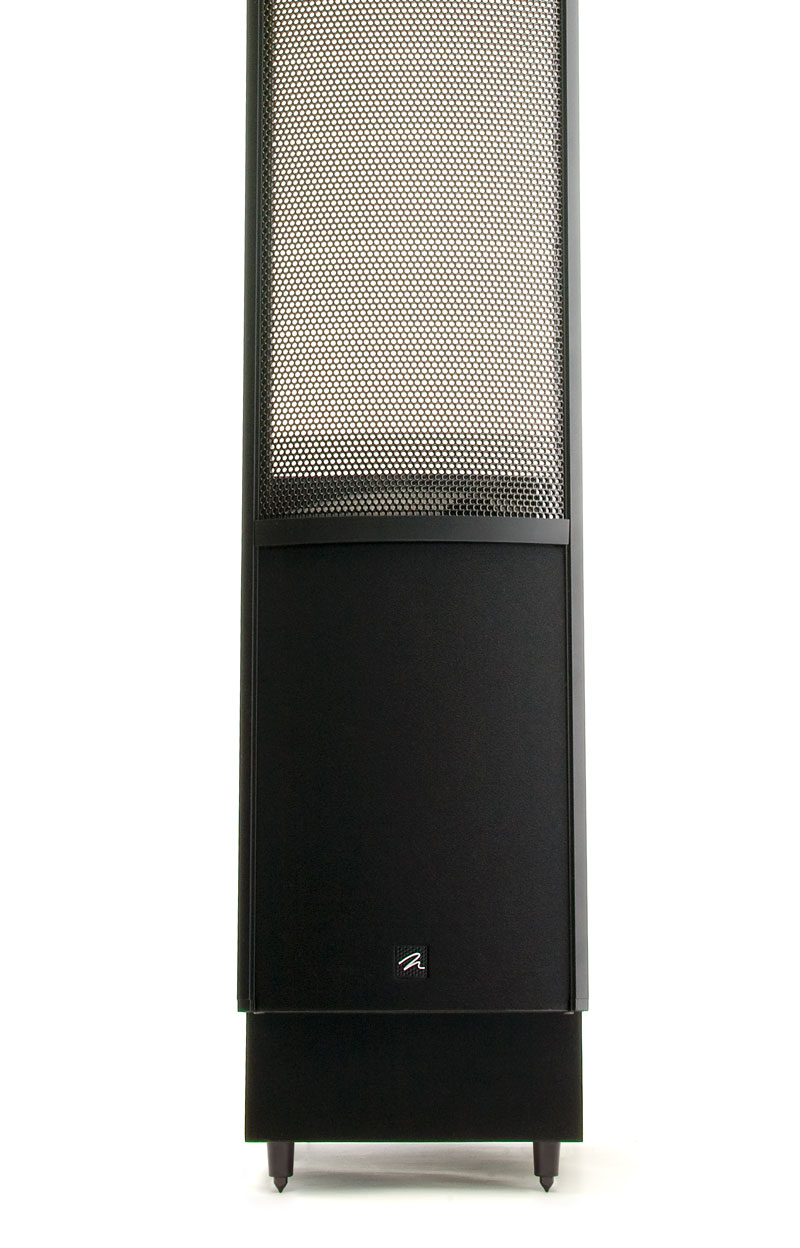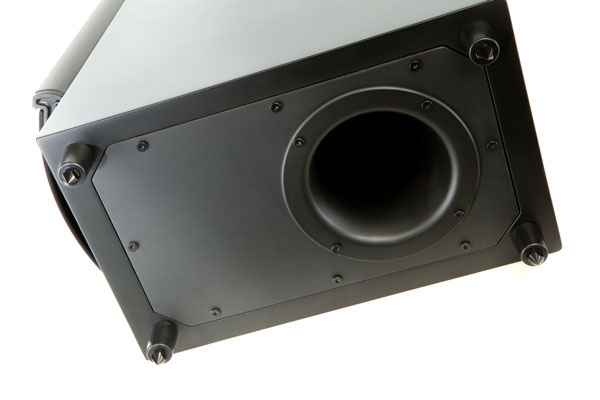MartinLogan ElectroMotion ESL
R32,000.00


A precise 8-inch high-excursion, perfectly balanced, audiophile grade, doped fiber cone woofer was custom designed exclusively for The EM-ESL by MartinLogan’s in-house engineering team. This woofer precisely optimizes cone suspension and magnetic flux field to produce high levels of bass output and simultaneous precise midrange. The custom woofer’s rigid light-weight diaphragm eliminates cone flexure and minimizes response time to achieve remarkably low-distortion approaching that of MartinLogan’s award-winning electrostatic panel design.
Easy Connections, Solid Adjustable Footing
Convenient push-style speaker terminals and curved inserts help guide speaker wire effortlessly into place. The rubber end caps on the terminal are also removable for the use of banana plugs instead of bare wire. The EM-ESL is supplied with sturdy, 3/8-16 ETC™ spikes, which can be used to fine tune vertical wave launch, enhance stability on thick carpets, and create tighter coupling between speaker and floor to provide a tighter and detailed bass performance. Each spike is conveniently covered by removable rubber end caps if you prefer not to use spikes.
 |
|
| That said, I had to admit that other speakers develop more down-low body. Be it my workhorse Neat Momentum 4i or various older review acquaintances like the PSB Synchrony One or Swans M6F, all those developed more physical force by which bass moved through the room without getting vague. My personal assumption is that during R&D for the ElectroMotion ESL, bass integration that’s accurate on time and control won out over ultimate bass power. In my opinion that was the right call to make too since anything else would have corrupted overall speed and immediacy. | ||
 |
||
|
|
||
|
| Pleasant and quite an advantage over traditional classic box systems was how well the ESL ‘watered’ the entire room. The effect of a positively engulfing sonic embrace could be had from nearly any position, perhaps not entirely surprising with all sounds being dispersed front and back. I did expect that tonality would take noticeable hits wandering about the room outside the actual sweet spot but not so. | ||
|
| Impressive and for me one of this design’s real strengths was the extremely dynamic ultra-clean midband which could tickle, caress or respond like lightning and with substantial shove. Voices and guitars became special friends – direct, immediate, well detailed, snappy but not spiked. As said before, down below the voicing was clean but more slim than potent even though it never lagged behind the truly greased vocal range. Dynamically the ElectroMotion ESL was quite astute. The song’s build-up and later collapse were both tracked accurately and believably. Here I thought the stats had the clear edge over my Neat Momentum 4i which handles the bass with more grit and gumption but doesn’t quite keep up with the panels’ small-scale dynamics. | |||||||||||||||||||
|
|||||||||||||||||||
| The Logans got on well with various amps. Aside from my usual Myryad MXA 2150, I also tried Audreal’s V30 valve amp and the dainty Yarland FV34CIII. Even the latter’s demure 10 watts managed to unearth impressive dynamics and fun from the stats’ passable efficiency if only to moderate room levels. The Audreal already sat fat inside rock levels. In short, an uncomplicated speaker. | |||||||||||||||||||
 |
|||||||||||||||||||
| Conclusion. Martin Logan’s ElectroMotion ESL are speakers that invite us on exciting musical travels. They generate an unusually live atmosphere and, within a decent sweet spot, very precise imaging and exacting depth layering embedded within an above-average dimensional scale. Tonally well balanced and subjectively seamless, the stats combine silky highs, a detailed dynamic midband and articulate if not ultimately voluminous bass. It’s a terrific choice for music lovers hoping to feast on an arrestingly involving presentation all for a highly competitive €3.190/pr price. The fetching industrial design with its smart semi-translucent panels also cuts a cosmetically winning profile. In short, the Martin Logan Electro-Motion ELS was my first electrostat but surely not the last. | |||||||||||||||||||
Description
Specifications
Specifications are subject to change without notice
| Frequency Response | 42–22,000 Hz ±3dB |
| Recommended Amplifier Power | 20—300 watts per channel |
| Horizontal Dispersion | 30° |
| Vertical Dispersion | 34″ (71cm) line source |
| Sensitivity | 91 dB/2.83 volts/meter |
| Impedance | 6 Ohms, 1.6 @ 20kHz Compatible with 4, 6, or 8 Ohm rated amplifiers. |
| Crossover Frequency | 500Hz |
| High Frequency Transducer | XStat™ CLS™ electrostaic transducer » Panel Dimensions: 34″ x 8.6″ (86 x 22cm) » Radiating Area: 292 in² (1,892 cm² ) |
| Low Frequency Transducer | 8″ (20.3cm) high excursion, high-rigidity paper cone with extended throw drive assembly, non-resonance asymmetrical chamber format; bass reflex |
| Components | Custom-wound audio transformer, air core coils, large steel laminate inductors, polyester capacitors, and low DF electrolytic capacitors |
| Inputs | Push style with banana jacks |
| Weight | 35.5 lbs. (16.1 kg) |
| Dimensions | 52.1″ x 9″ x 16.3 ” (132.3cm x 22.9cm x 41.4cm) |





 The ElectroMotion ESL (EM-ESL) represents a brave new direction for electrostatic loudspeaker design. Featuring a full-sized 34-inch tall curvilinear XStat™ electrostatic transducer the new ESL performs more like a mini-flagship than an entry level audiophile speaker. Long time MartinLogan enthusiasts are sure to describe ElectroMotion ESL as the second-coming of the legendary Aerius electrostatic speaker which debuted in 1992 and went on to sell in record numbers. The new ESL, however, boasts 40 percent more radiating surface, a superbly integrated and authoritative bass performance, and a sensitivity rated at 91dB. In addition, the ESL is capable of being effortlessly powered by both receivers and high-end amplifiers alike.
The ElectroMotion ESL (EM-ESL) represents a brave new direction for electrostatic loudspeaker design. Featuring a full-sized 34-inch tall curvilinear XStat™ electrostatic transducer the new ESL performs more like a mini-flagship than an entry level audiophile speaker. Long time MartinLogan enthusiasts are sure to describe ElectroMotion ESL as the second-coming of the legendary Aerius electrostatic speaker which debuted in 1992 and went on to sell in record numbers. The new ESL, however, boasts 40 percent more radiating surface, a superbly integrated and authoritative bass performance, and a sensitivity rated at 91dB. In addition, the ESL is capable of being effortlessly powered by both receivers and high-end amplifiers alike.
















